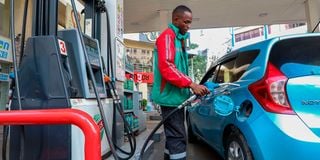Premium
Fuel shortage looms as marketers owed Sh53bn

Customer attendant serving a client at Rubis Petroleum Station on Koinange Street, Nairobi on January 15, 2023. The biting fuel shortage that hit the country last year could be back unless the government makes good on its promise to pay up to Sh53 billion subsidy cash owed to oil marketing companies.
The biting fuel shortage that hit the country last year could be back unless the government makes good on its promise to pay up to Sh53 billion subsidy cash owed to oil marketing companies.
The Sunday Nation has established that the Kenya Kwanza administration is yet to pay oil dealers subsidies on diesel and kerosene since taking office in September last year.
President William Ruto’s first act in office after assuming power was to scrap subsidies on petrol and maize flour, terming them unsustainable. However, a reduced subsidy of about Sh20 per litre of diesel and kerosene was retained to avoid raising the cost of transport beyond the reach of the majority of poor Kenyans.
“The smaller oil marketers are almost collapsing as they cannot pay their suppliers while the big multinationals are also hurting due to the big volumes they command which comes with hefty capital outlay,” said an oil marketer who requested anonymity, fearing reprisals from the state.
The subsidy payments are supposed to be submitted on a monthly basis, but the six-month delay now means the oil dealers are losing out on both their working capital as well as the exchange rate since the Treasury settles in the Kenya shilling that has been on a depreciation spiral.
The Sunday Nation’s multiple efforts to get a comment from Energy Cabinet Secretary Davis Chirchir through phone calls and text messages were unsuccessful.
Stalemate
Industry representatives through the Petroleum Institute of East Africa (PIES) have been meeting Energy ministry officials to discuss the matter but there has been no resolution as yet.
“They had promised to pay up last week but that was again changed to the coming week. This is not sustainable for much longer,” said the oil marketer.
Last year saw motorists suffer crippling fuel shortages as dealers held back supplies following similar delays in the release of subsidy refunds. Motorists had to wait in line for hours, sometimes spending nights in queues waiting to fill their tanks.
The intermittent shortages would then ease within hours of the Treasury releasing subsidy payments, costing the economy billions of shillings in lost productivity.
Treasury data shows oil marketers were paid up to Sh87.77 billion in subsidies in the nine months to September last year.
To address the oil dealers’ working capital pressure that comes with delayed subsidy remittances, the state had proposed to introduce government-to-government procurement of oil from the international markets, but the plans have not materialised since the publication of the regulations last year.
State-owned National Oil Corporation was supposed to start shipping fuel from Saudi Arabia’s Saudi Aramco, as opposed to the Open Tender System (OTS) that has seen dealers select the lowest bidder to import for the entire industry for nearly two decades.
The flop in the government-to-government deal nearly proved to be a costly mistake as cargo for March, which is normally ordered a month in advance, was not bought until mid-last week.
The state reverted to OTS to avert the looming crisis, with industry critics warning that the proposed procurement by the government will expose consumers to perennial shortages or even higher prices due to inherent government inefficiencies.





